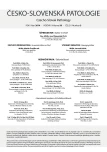-
Medical journals
- Career
A questionable bruise
Authors: Hossein Sanaei-Zadeh 1; Kamran Aghakhani 2
Authors‘ workplace: Medical School, Shiraz University of Medical Sciences, Shiraz, Iran 1; Department of Forensic Medicine and Toxicology, Iran University of Medical Sciences, Hazrat Rasoul Akram (p) Hospital, Tehran, Iran. 2
Published in: Soud Lék., 59, 2014, No. 3, p. 26-27
Category: Short Communication
Overview
It is occasionally difficult to distinguish between a self-inflicted bruise and true bruise. The important point of diagnosis is a good, thorough history taking and detailed examination of the affected area.
Keywords:
artificial bruise – assault – heparinAlthough rare, people may cause bruises on their bodies using blunt objects, pinching, squeezing, or sucking with different motives. It is occasionally difficult to distinguish between a false bruise and true bruise. However, a good history taking and physical examination will help in giving the final opinion. A 56-year-old man was admitted to the coronary care unit due to acute myocardial infarction. He was a known case of hypertension and ischemic heart disease. On visit, he was complaining of feeling chest pain and nausea after multiple blows to his face and chest during an altercation. On physical examination, subconjunctival hemorrhage in the left eye as well as a right side black eye was seen. Injury to other parts of the body was not detected. Four days later, in general medical ward, he claimed to have another bruise on his abdomen which he had not noticed before. On re-evaluation of the patient, there was a bruise of 5×5 cm in diameter on his abdomen. Also, there were several pale yellowish spots of varying diameter from 3 to 6 cm adjacent to this bruise (Fig. 1,2). The previous bruise around his eye and subconjunctival hemorrhage had completely been resolved. His general medical condition was good.
Fig. 1. Bruise on the patient’s abdomen. Several pale yellowish spots are seen close to the bruise. 
Fig. 2. Close-up photo of the patient’s bruise. 
According to the patient’s clinical chart, in the coronary care unit the patient had been treated by multiple subcutaneous heparin injections in his abdomen. Subcutaneous administration of heparin often causes problems such as bruise, pain, induration, and hematoma at the injection site (1,2). Therefore, this bruise and other spots could not be due to the assault and were definitely because of multiple injections.
Correspondence address:
Dr. Hossein Sanaei-Zadeh
Medical School, Shiraz University of Medical Sciences
Emergency Room/Division of Medical Toxicology
Hazrat Ali-Asghar (p) Hospital
Meshkinfam Street, 7143918796 Shiraz, Iran
e-mail: sanaeizadeh@sums.ac.ir
Sources
1. Avşar G, Kaşikçi M. Assessment of four different methods in subcutaneous heparin applications with regard to causing bruise and pain. Int J Nurs Pract 2013; 19 : 402-408.
2. Palese A, Aidone E, Dante A, Pea F. Occurrence and extent of bruising according to duration of administration of subcutaneous low-molecular-weight heparin: A quasi-experimental case-crossover study. J Cardiovasc Nurs 2013; 28 : 473-482.
Labels
Anatomical pathology Forensic medical examiner Toxicology
Article was published inForensic Medicine

2014 Issue 3
Most read in this issue- The Application of X-ray Imaging in Forensic Medicine
- Injuries associated with cardiopulmonary resuscitation
- A questionable bruise
- A case of arrhythmogenic right ventricular cardiomyopathy (ARVC/D) in which tenascin C immunostaining made the assessment of myocardial remodeling possible
Login#ADS_BOTTOM_SCRIPTS#Forgotten passwordEnter the email address that you registered with. We will send you instructions on how to set a new password.
- Career

